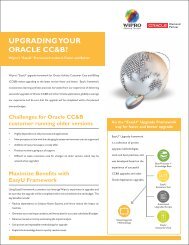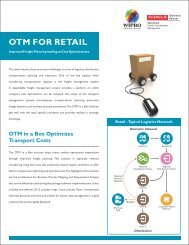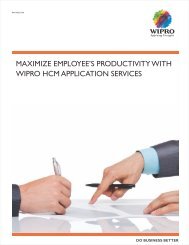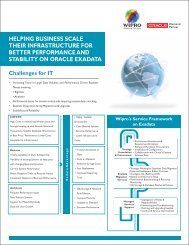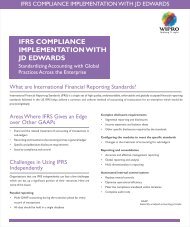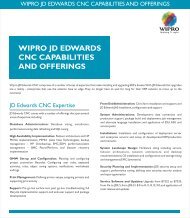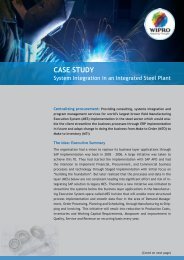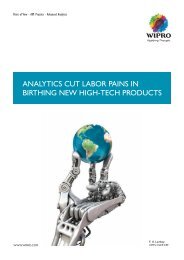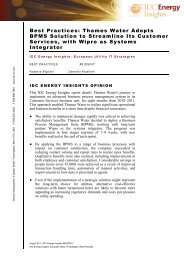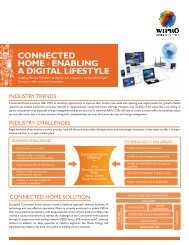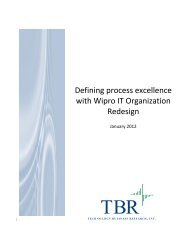Knowledge Management Strategies for Mitigating the Big Crew - Wipro
Knowledge Management Strategies for Mitigating the Big Crew - Wipro
Knowledge Management Strategies for Mitigating the Big Crew - Wipro
You also want an ePaper? Increase the reach of your titles
YUMPU automatically turns print PDFs into web optimized ePapers that Google loves.
<strong>Knowledge</strong> <strong>Management</strong> <strong>Strategies</strong> <strong>for</strong><br />
<strong>Mitigating</strong> <strong>the</strong> <strong>Big</strong> <strong>Crew</strong> Change in E&P<br />
William Barna<br />
MBA<br />
WIPRO TECHNOLOGIES
TABLE OF CONTENTS<br />
Executive Summary ...................................................................................3<br />
Introduction ..............................................................................................4<br />
The Challenge ...........................................................................................5<br />
<strong>Wipro</strong>’s Business Solution ........................................................................7<br />
Technical Solution ....................................................................................12<br />
Conclusion ...............................................................................................15<br />
Appendix .................................................................................................16<br />
References ..............................................................................................16<br />
About <strong>the</strong> Author ...................................................................................17
<strong>Knowledge</strong> <strong>Management</strong> <strong>Strategies</strong> <strong>for</strong> mitigating <strong>the</strong> <strong>Big</strong> <strong>Crew</strong> Change in E&P<br />
Successfully finding and producing oil requires a team of highly trained and experienced engineers. In most oil companies <strong>the</strong><br />
average age of an engineer is 48; 50% will be retiring within 10 years. Un<strong>for</strong>tunately, <strong>the</strong>re are no replacements <strong>for</strong> <strong>the</strong>se<br />
retirees and companies will experience decreased production levels, reduced profitability and an increase in accident rates.<br />
While new college graduates will fill some of <strong>the</strong> gaps, <strong>the</strong>re are nei<strong>the</strong>r enough of <strong>the</strong>se personnel nor do <strong>the</strong>y have <strong>the</strong><br />
necessary skills. <strong>Wipro</strong> believes <strong>the</strong> best way to address this issue is with knowledge communities that keep retirees available as<br />
consultants and with professional networking technologies that improve collaboration.<br />
Executive Summary<br />
The Oil and Gas Industry will be facing an enormous challenge over <strong>the</strong> next decade, when nearly 50% of its work<strong>for</strong>ce will be<br />
eligible <strong>for</strong> retirement. When <strong>the</strong>se employees leave <strong>the</strong>y will be taking <strong>the</strong>ir experience and institutional knowledge with <strong>the</strong>m.<br />
Exploration and Production (E&P) will be particularly hard hit because of its reliance on world class engineering talent. The most<br />
successful engineers are those who have 20 years of experience or more. Finding and producing oil is a combination of instinct<br />
and science. While <strong>the</strong> science can be taught in universities, instincts come from experience. To make matters worse, <strong>the</strong>re are<br />
few mid-career engineers in <strong>the</strong> pipeline to replace <strong>the</strong> seasoned veterans. Depressed oil prices in <strong>the</strong> 1980s and 1990s<br />
significantly decreased <strong>the</strong> number of engineers entering <strong>the</strong> industry. While <strong>the</strong> number of new engineers is increasing, <strong>the</strong>re<br />
will not be enough of <strong>the</strong>m to replace those who are leaving. Even if quantities were sufficient, <strong>the</strong>ir lack of experience would<br />
make <strong>the</strong>m largely ineffective.<br />
The impact on <strong>the</strong> industry will be enormous. As <strong>the</strong> world economy grows, demand <strong>for</strong> fossil fuels increases. At <strong>the</strong> same time,<br />
<strong>the</strong> world’s “easy” oil has already been found. The remaining oil is located is small, engineering-intensive fields, in depleted oil<br />
fields requiring enhanced recovery, and in deep water. Getting at <strong>the</strong>se hydrocarbons will require <strong>the</strong> most talented engineers<br />
with decades of experience. These are <strong>the</strong> same people who are leaving <strong>the</strong> industry.<br />
The demographics of <strong>the</strong> labor market have also changed. While <strong>the</strong>re is a large deficit of engineering talent in North America<br />
and <strong>the</strong> Middle East, <strong>the</strong>re is a surplus of talent in China and India. If oil and gas companies are going to remain competitive,<br />
<strong>the</strong>y are going to have to find a way to tap into this labor pool.<br />
<strong>Wipro</strong>, in conjunction with Microsoft and Rice University, has studied this challenge extensively and believes that a combination<br />
of new business processes and supporting technologies can partially mitigate <strong>the</strong> impact of <strong>the</strong> “<strong>Big</strong> <strong>Crew</strong> Change”. <strong>Wipro</strong>’s<br />
solution is to develop knowledge communities that include on-duty, off-duty, Center of Excellence alumni association<br />
consultants and partners/vendors. New collaborative and communications technologies will allow this group to function in a<br />
virtual environment. One of <strong>the</strong> key innovations <strong>for</strong> this solution is <strong>the</strong> knowledge market where off-duty and retired employees<br />
can work as consultants to solve problems and support projects.<br />
<strong>Wipro</strong>’s solution is based on <strong>the</strong> Microsoft Office SharePoint Server (MOSS) 2007 plat<strong>for</strong>m and includes Microsoft’s Unified<br />
Communications Product suite. The technical solution will support <strong>the</strong> knowledge communities with intranet and extranet<br />
portals and real-time communications. The system will integrate into existing knowledge management, asset management,<br />
condition-based maintenance, SCADA1 monitoring, troubleshooting and ERP2 systems. Professional networking technologies<br />
will link assets to processes to people. Powerful search engines will allow <strong>the</strong> user community to quickly locate in<strong>for</strong>mation and<br />
more importantly, <strong>the</strong> people who have <strong>the</strong> in<strong>for</strong>mation. Mobile communications devices based on Smartphones will make it<br />
possible <strong>for</strong> off-duty and retired employees to be on-call without interfering with <strong>the</strong>ir personal time.<br />
3 | www.wipro.com/industryresearch<br />
WIPRO TECHNOLOGIES
<strong>Knowledge</strong> <strong>Management</strong> <strong>Strategies</strong> <strong>for</strong> mitigating <strong>the</strong> <strong>Big</strong> <strong>Crew</strong> Change in E&P<br />
This solution has <strong>the</strong> ability to save or create billions of dollars of oil revenue <strong>for</strong> individual companies. It will also help <strong>the</strong><br />
industry meet <strong>the</strong> energy demands of <strong>the</strong> world economy at a time when <strong>the</strong> industry’s best and brightest are leaving <strong>the</strong><br />
[1] [2]<br />
work<strong>for</strong>ce.<br />
Introduction<br />
<strong>Wipro</strong> Consulting Services (WCS) has been delivering knowledge management strategies <strong>for</strong> its oil and gas customers since 1990,<br />
thus improving collaboration, regulatory compliance and operations. Within <strong>the</strong> last 5 years demand has increased <strong>for</strong> solutions<br />
to address <strong>the</strong> “<strong>Big</strong> <strong>Crew</strong> Change”. <strong>Wipro</strong> has worked with its customers on this issue and believes it has a solution that is<br />
applicable across <strong>the</strong> industry. This paper provides a solution overview and helps oil and gas companies with <strong>the</strong>ir strategies.<br />
Effective solutions improve business processes. Technology’s role is to act as an enabler, making it possible to do business in new<br />
ways. It is constantly changing, creating new opportunities. Breakthroughs in knowledge management, unified communications<br />
and social computing are providing value tools <strong>for</strong> reshaping business processes that can offset <strong>the</strong> impact of <strong>the</strong> <strong>Big</strong> <strong>Crew</strong><br />
Change.<br />
Microsoft is an industry leader in many of <strong>the</strong>se technologies. Microsoft Office SharePoint Server (MOSS) 2007 Enterprise<br />
provides team collaboration, document management, records management, search, enterprise portals and o<strong>the</strong>r key<br />
functionality that can provide <strong>the</strong> foundation <strong>for</strong> any knowledge management system. Microsoft.s Unified Communications<br />
Solution integrates cleanly with MOSS and provides Voice-over-IP, presence, group chat and video conferencing. The<br />
combination of <strong>the</strong>se two technologies has added new capabilities to <strong>the</strong> marketplace that can be used to rethink how<br />
business has been done and provide new levers to use in coping with <strong>the</strong> <strong>Big</strong> <strong>Crew</strong> Change.<br />
Microsoft included social networking in MOSS 2007 and plans to refine <strong>the</strong> technologies in SharePoint 14. While social<br />
networking technologies used in sites such as Facebook or MySpace have proven enormously popular with consumers, many<br />
businesses have failed to see <strong>the</strong> value of incorporating <strong>the</strong>se technologies into <strong>the</strong>ir knowledge management infrastructure.<br />
Wikis, blogs, <strong>for</strong>ums, and people searches have been seen as too imprecise and unregulated to be effective tools <strong>for</strong> operations.<br />
These tools, however, play an important role in <strong>Wipro</strong>’s solution. Instead of installing social networking components on a<br />
Website, <strong>Wipro</strong> has integrated <strong>the</strong>m into new business processes. It has provided governance models and employee incentives<br />
to increase user acceptance. In <strong>Wipro</strong>’s solution implementation, <strong>the</strong>se tools are referred to as Professional Networking tools in<br />
order to differentiate between what consumers use on <strong>the</strong> Internet and what would be built into a corporate knowledge<br />
management system.<br />
Using <strong>the</strong>se tools in an oil and gas business environment is not new and many companies are experimenting with this<br />
technology on a small scale. A good example is Occidental Petroleum Corporation. Oxy has deployed a wiki site called Oxypedia<br />
to 300 users in its Elk Hills operation.3 Elk Hills supports operations in Cali<strong>for</strong>nia where Oxy is <strong>the</strong> largest gas producer and third<br />
largest oil producer in <strong>the</strong> state. The site received 1500 hits on its first day and user acceptance has been excellent.<br />
The wiki is a repository <strong>for</strong> best practices and includes in<strong>for</strong>mation on topics like normalizing well data, default settings <strong>for</strong><br />
<strong>for</strong>ecasting software such as Peep and Aires, and how to evaluate well data in Microsoft Excel.<br />
4 | www.wipro.com/industryresearch<br />
WIPRO TECHNOLOGIES
<strong>Knowledge</strong> <strong>Management</strong> <strong>Strategies</strong> <strong>for</strong> mitigating <strong>the</strong> <strong>Big</strong> <strong>Crew</strong> Change in E&P<br />
In <strong>Wipro</strong>’s implementation of wikis, <strong>the</strong>se elements are built into a much larger solution that links wikis to people, assets and<br />
processes, while using next generation search engines to quickly locate <strong>the</strong> in<strong>for</strong>mation needed to solve a problem or locate a<br />
person who has <strong>the</strong> required knowledge. The solution goes one step fur<strong>the</strong>r through communities and markets that greatly<br />
increase <strong>the</strong> knowledge pool. This will become critical as more and more knowledge leaves companies as people retire.<br />
<strong>Wipro</strong> has been studying this issue since 2007 and has worked with Rice University, Microsoft and customers <strong>for</strong>mally and<br />
in<strong>for</strong>mally. <strong>Wipro</strong> is a Silver sponsor of Rice’s Energy <strong>Management</strong> program. Since <strong>Wipro</strong> plans to base this solution on <strong>the</strong> MOSS<br />
plat<strong>for</strong>m, Microsoft has funded research and provided technical expertise. Many of <strong>Wipro</strong>’s customers have shared in<strong>for</strong>mation<br />
on <strong>the</strong>ir internal research programs. <strong>Wipro</strong> has provided a Proof-of-Concept (POC) to Petrobras in Houston, TX. Petrobras is<br />
[3]<br />
evaluating <strong>the</strong> POC’s ability to improve offshore operations in <strong>the</strong> Gulf of Mexico (GOM).<br />
The Challenge<br />
Most of <strong>the</strong> world’s “easy” oil is gone, <strong>for</strong>cing oil companies to focus on smaller oil fields, enhanced recovery, and deepwater oil.<br />
4All three are engineering intensive and require large capital investments. This is happening at a time when most of <strong>the</strong><br />
industry’s top engineering talent is about to retire. Making matters worse, universities are only providing a fraction of what is<br />
needed to replace <strong>the</strong> retirees. As a result, <strong>the</strong> oil industry is in a crisis.<br />
Twenty years ago <strong>the</strong>re were fifteen “Super Giant” oil fields capable of producing a million barrels per day. Today <strong>the</strong>re are only<br />
four.5 In order to meet production targets, companies are producing larger numbers of smaller fields. These smaller fields are<br />
resource-intensive, requiring substantially more engineering hours per barrel of oil produced. Smaller fields also scatter<br />
engineers, reducing productivity. Since it is unlikely that new Super Giant fields will be discovered, smaller fields will<br />
produce more and more of <strong>the</strong> world’s oil. As a result, <strong>the</strong> demand <strong>for</strong> petroleum engineers will increase year after year unless<br />
technology can be used to offset this trend.<br />
Since low-cost oil is becoming harder and harder to find, <strong>the</strong> industry is revisiting depleted oil fields with enhanced recovery<br />
technologies such as gas injection, chemical injection, ultrasonic stimulation, microbial recovery and <strong>the</strong>rmal recovery. In a<br />
typical field only 20% to 40% of <strong>the</strong> oil can be produced by primary and secondary recovery means. With enhanced recovery this<br />
improves to 30% to 60%. The downside is <strong>the</strong> expense and <strong>the</strong> fact that it is engineering intensive. As energy prices increase,<br />
enhanced recovery makes economic sense. However, it will also fur<strong>the</strong>r strain engineering resources.<br />
Seven of <strong>the</strong> last 10 Giant oil fields have been discovered in deep water off Brazil, in <strong>the</strong> Gulf of Mexico and in <strong>the</strong> Persian Gulf.<br />
Giant oil fields are capable of producing more than 100,000 barrels of oil per day or 10 percent of a Super Giant. For example,<br />
BP’s Thunderhorse plat<strong>for</strong>m 150 miles sou<strong>the</strong>ast of New Orleans in <strong>the</strong> Gulf of Mexico now produces between 100,000 and<br />
300,000 barrels of oil. It came on line with seven wells in 20086. Future production may hit as much as a million barrels of oil per<br />
day from up to 50 wells. The semi-submersible plat<strong>for</strong>m cost over $1 billion dollars to build and accounts <strong>for</strong> 3.3% of current U.S.<br />
oil production. Thunderhorse was originally planned to come on line in 2005 and ran three years behind schedule. It is widely<br />
believed that a shortage of engineering talent contributed to <strong>the</strong> delay. Since <strong>the</strong>re are likely few Giants and Super Giants left to<br />
be found on shore, <strong>the</strong> future of oil production will move off shore. This will fur<strong>the</strong>r stress <strong>the</strong> short supply of engineering staff.<br />
5 | www.wipro.com/industryresearch<br />
WIPRO TECHNOLOGIES
<strong>Knowledge</strong> <strong>Management</strong> <strong>Strategies</strong> <strong>for</strong> mitigating <strong>the</strong> <strong>Big</strong> <strong>Crew</strong> Change in E&P<br />
[4] [5] [6] The average age of oil field engineers is 48 and 50% to 60% will be eligible <strong>for</strong> retirement within 10 years. The expected<br />
attrition rate is 6% per year.7 The disciplines hardest hit include petroleum engineers, process engineers, geologists, and<br />
geophysicists. Employee age also follows a bimodal distribution with a large number of older employees, a number of younger<br />
employees and not much in <strong>the</strong> middle. A good example is Halliburton, where 56% of employees have less than five years of<br />
experience, 17% have 5 to 10 years’ experience, and 27% have more than 10 years’ experience.8 Halliburton is considered a<br />
young company in <strong>the</strong> industry with bimodal distribution over-weighted at <strong>the</strong> young side of <strong>the</strong> curve. Aramco is a similar<br />
example. According to Allah Al-Saif, Senior VP of E&P, "nearly half of our work<strong>for</strong>ce [Saudi Aramco] is less than 30 years of age.<br />
Fur<strong>the</strong>rmore, surveys suggest that in <strong>the</strong> next few years more than 60 per cent of our engineers will have less than 10 years of<br />
experience”.<br />
The industry will be most at risk when <strong>the</strong> experienced employees retire, shifting <strong>the</strong> small middle group into leadership with<br />
support from a large group of inexperienced employees.<br />
Work<strong>for</strong>ce volatility is not new to <strong>the</strong> oil and gas industry; it has been an issue <strong>for</strong> <strong>the</strong> last 150 years. As <strong>the</strong> price of oil climbs,<br />
companies quickly hire. As oil prices fall, companies lay off. Since <strong>the</strong> 1980s <strong>the</strong> price of oil has gone from <strong>the</strong> $10s to <strong>the</strong> $140s<br />
and back to <strong>the</strong> $50s today. The work<strong>for</strong>ce demographics reflect this. However, oil price volatility is only one component. The <strong>Big</strong><br />
<strong>Crew</strong> Change has its roots in <strong>the</strong> 1980s and 1990s and occurred <strong>for</strong> three reasons:<br />
1. Mergers and low oil prices caused hundreds of thousands of people to leave <strong>the</strong> industry<br />
2. The image of E&P as low-tech and a dirty, sunset industry makes it less attractive <strong>for</strong> young people<br />
3. Competition from o<strong>the</strong>r industries<br />
There is also a regional graduation deficit <strong>for</strong> E&P engineers. The US enrolment in key E&P industry skills like petroleum<br />
engineering fell 85% between 1982 and 2003. For example, in 1993 <strong>the</strong>re were 11,000 petroleum engineering students in <strong>the</strong><br />
United States at 34 universities. By 2005, that number had plummeted to 1700 people at 17 universities. 10While <strong>the</strong> situation<br />
in <strong>the</strong> United States is grim, in parts of <strong>the</strong> world such as India and China <strong>the</strong>re is a surplus.<br />
In 2006, Schlumberger Business Consulting surveyed 115 universities and 30 companies to compare available labor and<br />
demand.11 The results of <strong>the</strong> survey showed major deficits in <strong>the</strong> United States, Canada, Russia, Saudi Arabia and Iran. Major<br />
surpluses were found in China, Indonesia, India, Venezuela and Mexico. The deficits and surpluses roughly balance <strong>the</strong>mselves.<br />
One of <strong>the</strong> challenges going <strong>for</strong>ward will be to ei<strong>the</strong>r relocate <strong>the</strong>se engineers closer to <strong>the</strong>ir work or to find new ways to<br />
leverage <strong>the</strong>m in <strong>the</strong>ir native countries.[7] [8]<br />
6 | www.wipro.com/industryresearch<br />
WIPRO TECHNOLOGIES
<strong>Knowledge</strong> <strong>Management</strong> <strong>Strategies</strong> <strong>for</strong> mitigating <strong>the</strong> <strong>Big</strong> <strong>Crew</strong> Change in E&P<br />
[9] [10] [11] Over <strong>the</strong> next 15 years, <strong>the</strong> industry plans to expand capacity by investing over $200 billion in E&P. In order to support this<br />
growth rate, a solution to <strong>the</strong> talent issue must be found. Since it is too late to do anything about <strong>the</strong> mid-career gap in <strong>the</strong><br />
work<strong>for</strong>ce, solutions will need to focus on five areas:<br />
1. Keeping institutional knowledge in <strong>the</strong> system longer<br />
2. Improving collaboration between employees<br />
3. Developing IT systems that can mimic experienced employees<br />
4. Providing more effective programs to reduce <strong>the</strong> time needed <strong>for</strong> new employees to become productive<br />
5. Creating processes <strong>for</strong> leveraging surplus labor in deficit markets<br />
New technologies that enable new business processes are showing great promise and may be <strong>the</strong> most effective way to<br />
developing a strategy <strong>for</strong> mitigating <strong>the</strong> impact of <strong>the</strong> <strong>Big</strong> <strong>Crew</strong> Change.<br />
<strong>Wipro</strong>’s Business Solution<br />
<strong>Wipro</strong>’s solution <strong>for</strong> <strong>the</strong> <strong>Big</strong> <strong>Crew</strong> Change is to <strong>for</strong>m knowledge communities that are linked toge<strong>the</strong>r through collaborative<br />
technologies provided by Microsoft’s MOSS 2007 Enterprise and Unified Communications plat<strong>for</strong>ms. Custom applications<br />
delivered through Webparts in portals would be used to provide specialized functionality. Incentive programs would be used to<br />
increase user acceptance and improve change management.<br />
<strong>Knowledge</strong> communities address <strong>the</strong> requirement of keeping institutional knowledge in <strong>the</strong> system during <strong>the</strong> period of <strong>the</strong> <strong>Big</strong><br />
<strong>Crew</strong> Change. The new electronic systems and business processes associated with <strong>the</strong> communities will address <strong>the</strong> second<br />
requirement of improved collaboration.<br />
These communities will consist of 5 groups:<br />
1. On-duty employees supporting operations<br />
2. Off-duty employees supporting operations<br />
3. Center of Excellence (COE) employees<br />
4. Partners and vendors<br />
5. Alumni consultants<br />
The five groups would be brought toge<strong>the</strong>r as a virtual team through a portal that is accessible both internally through <strong>the</strong><br />
corporate intranet and externally through an extranet. Unified communications and mobile systems provide ubiquitous<br />
communications allowing each participant to support <strong>the</strong> community from any location and at any time.<br />
7 | www.wipro.com/industryresearch<br />
WIPRO TECHNOLOGIES
<strong>Knowledge</strong> <strong>Management</strong> <strong>Strategies</strong> <strong>for</strong> mitigating <strong>the</strong> <strong>Big</strong> <strong>Crew</strong> Change in E&P<br />
On-duty and COE employees would access <strong>the</strong> portal through <strong>the</strong> corporate intranet. MOSS would be used to provide a personal<br />
site <strong>for</strong> each employee. The content of <strong>the</strong> site would be dictated by group membership and job function. Employees could<br />
customize pages by adding additional components. Webparts would be used to deliver functionality. Personal sites would<br />
include <strong>the</strong> following components:<br />
• Homepage<br />
• Operations subpage<br />
• Community subpage<br />
Homepage<br />
Operations dashboard<br />
Community dashboard<br />
<strong>Knowledge</strong> management<br />
dashboard<br />
Links to subpages<br />
Scripted troubleshooting process<br />
Process linked to tickets db, asset<br />
db, personnel db<br />
Employee presence<br />
Group chat<br />
LiveMeeting<br />
If an issue should arise that cannot be handled through <strong>the</strong> scripted troubleshooting process and knowledge management<br />
interfaces, <strong>the</strong> next escalation point would be <strong>the</strong> center of excellence. Most oil and gas companies already have COEs in place<br />
that can easily be integrated into <strong>the</strong> solution. For example, Petrobras uses Petrobras University and its Central Research Group<br />
as its COEs. If an E&P issue arises in Petrobras Americas that cannot be solved locally, <strong>the</strong> issue is escalated to <strong>the</strong>se COEs in Rio<br />
de Janeiro in Brazil.<br />
Ano<strong>the</strong>r example is Shell's COE in Bangalore India.12 Internally, <strong>the</strong> system is known as <strong>the</strong> Collaborative Work Environment.<br />
"The Collaborative Work Environment allows us [Shell] to view real-time operational data from our worldwide<br />
production; drilling; refining and manufacturing operations, in surveillance rooms in Bangalore. Subject Matter Expert in<br />
Bangalore can <strong>the</strong>n offer technical advice directly to asset teams during operational activities." This system is also integrated<br />
[12]<br />
with o<strong>the</strong>r Shell COEs in Amsterdam, Ne<strong>the</strong>rlands and o<strong>the</strong>r parts of <strong>the</strong> world.<br />
8 | www.wipro.com/industryresearch<br />
Operations subpage<br />
Breakout <strong>for</strong> operations KPIs<br />
KPIs associated with assets,<br />
people and process<br />
Asset database access<br />
Employee presence in<strong>for</strong>mation<br />
Process documentation<br />
Search<br />
Employee presence in<strong>for</strong>mation<br />
Group chat<br />
LiveMeeting<br />
Link to <strong>Knowledge</strong> market<br />
• Troubleshooting subpage<br />
• <strong>Knowledge</strong> <strong>Management</strong> subpage<br />
• <strong>Knowledge</strong> Market subpage<br />
Community subpage<br />
Professional networking<br />
Employee presence in<strong>for</strong>mation<br />
Group chat<br />
LiveMeeting<br />
Troubleshooting subpage <strong>Knowledge</strong> <strong>Management</strong><br />
subpage<br />
<strong>Knowledge</strong> Market subpage<br />
Products<br />
Consultant availability<br />
Consultat bios<br />
Pricing<br />
Consultat presence in<strong>for</strong>mation<br />
Group Chat<br />
LiveMeeting<br />
VoIP communications<br />
WIPRO TECHNOLOGIES
<strong>Knowledge</strong> <strong>Management</strong> <strong>Strategies</strong> <strong>for</strong> mitigating <strong>the</strong> <strong>Big</strong> <strong>Crew</strong> Change in E&P<br />
On-duty and COE personnel will have incentives to contribute <strong>the</strong>ir knowledge to <strong>the</strong> system through a compensation model<br />
based on <strong>the</strong> value of contributions. Value would be determined by <strong>the</strong>ir peers as <strong>the</strong> in<strong>for</strong>mation was consumed to address<br />
business problems. The knowledge management system would track how often <strong>the</strong> in<strong>for</strong>mation was accessed and <strong>the</strong><br />
consumers would provide feedback about <strong>the</strong> end result. A point system would be used to show impact and a dashboard would<br />
allow each employee or an employee’s manager to monitor results. The organization could provide bonuses based on<br />
per<strong>for</strong>mance, allow points to be used to make purchases from a company store or used in <strong>the</strong> evaluation process when<br />
considering promotions or increases in annual compensation.<br />
Off-duty employees, vendors, partners, and alumni consultants would access systems through an extranet site. Off-duty and<br />
alumni consultants would participate through a knowledge market while partners and vendors would use a scaled down version<br />
of <strong>the</strong> internal site.<br />
Getting off-duty and retired alumni association employees to participate will require an incentive program. The knowledge<br />
market allows stakeholders to flexibly volunteer <strong>the</strong>ir time in exchange <strong>for</strong> financial compensation. Each participant signs up <strong>for</strong><br />
<strong>the</strong> program and provides a profile. Off-duty employees will have <strong>the</strong>ir profile uploaded from <strong>the</strong> internal system and fill in<br />
additional in<strong>for</strong>mation about <strong>the</strong> times <strong>the</strong>y are available and <strong>the</strong> rates <strong>the</strong>y would expect.<br />
Retired employees would join an alumni association prior to signing up as consultants. The consultants would sign non-<br />
disclosure agreements. They would receive background checks and be required to comply with security policies. They would also<br />
fill out a complete profile with <strong>the</strong>ir work history, certifications, expertise with specific processes and equipment, availability and<br />
consulting rate. There would be an evaluation system that tracks <strong>the</strong> quality of <strong>the</strong>ir work over time.<br />
Depending on company policies and available talent, <strong>the</strong> alumni association would be local to <strong>the</strong> company or could include<br />
retirees from similar firms. Existing services like “Expert Alumni” could also be integrated into <strong>the</strong> solution. Expert Alumni13 is a<br />
service that provides retirees to <strong>the</strong> oil and gas industry as consultants. It is sponsored by <strong>the</strong> Society of Petroleum Engineers<br />
and was specifically designed to help organizations deal with <strong>the</strong>ir staffing and knowledge transfer issues during <strong>the</strong> <strong>Big</strong> <strong>Crew</strong><br />
Change.<br />
Security <strong>for</strong> <strong>the</strong> knowledge market would be set by <strong>the</strong> company. In all likelihood, <strong>the</strong> company would enact a “need to know”<br />
policy. The individual purchasing <strong>the</strong> consulting would be responsible <strong>for</strong> granting access to specific company resources. The<br />
knowledge management system would track usage and provide an audit trail back to <strong>the</strong> purchaser. Upon completion of <strong>the</strong><br />
engagement, <strong>the</strong> project would be closed and access to resources would be automatically revoked.<br />
Off-duty and alumni association personnel would be given incentives to contribute to <strong>the</strong> knowledge base in <strong>the</strong> same way as<br />
on-duty employees, with <strong>the</strong> exception of having <strong>the</strong>ir submissions reviewed by a review board. The review board would<br />
evaluate <strong>the</strong> in<strong>for</strong>mation <strong>for</strong> quality and ensure <strong>the</strong>re was no duplication with existing works. Once accepted, <strong>the</strong> system would<br />
be uploaded into <strong>the</strong> primary system.<br />
For employees participating in <strong>the</strong> knowledge market, a local account would be maintained through<strong>the</strong> extranet site. A Paypal-<br />
like system would be used to transfer funds from <strong>the</strong> market to <strong>the</strong> bank account.<br />
9 | www.wipro.com/industryresearch<br />
WIPRO TECHNOLOGIES
<strong>Knowledge</strong> <strong>Management</strong> <strong>Strategies</strong> <strong>for</strong> mitigating <strong>the</strong> <strong>Big</strong> <strong>Crew</strong> Change in E&P<br />
[13] Partners and vendors are a key component of <strong>the</strong> solution since <strong>the</strong>y have expertise with equipment and <strong>the</strong>n services that<br />
may not be available in-house. A separate extranet site will be used <strong>for</strong> this group. It will have <strong>the</strong> functionality of knowledge<br />
market minus <strong>the</strong> compensation component. Partners and vendors will have an interest in ensuring that <strong>the</strong>y are adding value<br />
to <strong>the</strong>ir customer in order to secure future sales. No additional compensation model would be required.<br />
Business users would have access to <strong>the</strong> full community through portal application. They would likely first attempt to solve<br />
issues or support projects locally and <strong>the</strong>n leverage <strong>the</strong> COEs followed by partners/vendors and <strong>the</strong>n as a last resort use <strong>the</strong><br />
knowledge markets.<br />
No matter how effective <strong>the</strong> knowledge community is, <strong>the</strong>re will be gaps. Some employees will choose not to join alumni<br />
associations as consultants and <strong>the</strong>re will likely never be enough consultants to meet demand. Organizations will need to invest<br />
in operations research and expert systems to fill this need.<br />
Operations Research (OR) uses ma<strong>the</strong>matics and analytical computer-based methods to optimize scheduling to improve<br />
operations. In oil field operations veteran managers are able to use <strong>the</strong>ir experience to optimally schedule resources. Developing<br />
or producing an oil field requires a number of steps to be per<strong>for</strong>med serially or in parallel. Knowing how to budget time or<br />
estimate risks to timelines is largely a function of experience. When <strong>the</strong>se experienced employees retire, systems like <strong>the</strong>se will<br />
be required to back fill <strong>the</strong>m until <strong>the</strong> next generation of <strong>the</strong> work<strong>for</strong>ce gains experience.<br />
Below are two examples of OR systems improving operations from a recent Society of PetroleumEngineers paper titled “The<br />
Impending Expertise Crisis: New Technology Comes to <strong>the</strong> Rescue”.<br />
[14] “Saudi Aramco, <strong>the</strong> world’s largest oil producing company, realized strong improvements in key per<strong>for</strong>mance indicators after<br />
deploying Actenum’s Rig Activity Scheduler.”<br />
“The Canadian oil sands extraction company Syncrude avoided an unplanned downtime estimated at a cost of $32 million within<br />
two weeks of using a reliability driven maintenance scheduling prototype.”<br />
Expert systems use Artificial Intelligence algorithms to replace human beings. These systems use manytechnologies including<br />
rule based systems, fuzzy logic and neural networks. AI systems are most appropriate to:<br />
• Get better value from large amounts of operational data<br />
• Help experts to make better decisions by focusing on trends ra<strong>the</strong>r than details<br />
• Providing decision support that improves <strong>the</strong> effectiveness of non-experts<br />
One example is a fuzzy logic system developed by <strong>the</strong> Petroleum Recovery Research Center (PRRC), New Mexico Institute of<br />
Mining and Technology, Socorro, NM. The U.S. Department of Energy funded $523,500 of this 36 month project. Below is an<br />
excerpt from <strong>the</strong> team’s objective statement.<br />
“The objective of this project is to create a user-definable and customizable fuzzy expert system tool to dramatically speed local<br />
and regional play analysis and reduce subsequent drilling risk. This general tool will not require significant knowledge of<br />
computer<br />
programming and will guide users through <strong>the</strong> process of building a successful expert<br />
system to evaluate plays from field to basin scale using public and/or private data and <strong>the</strong>ir own knowledge.<br />
10 | www.wipro.com/industryresearch<br />
WIPRO TECHNOLOGIES
<strong>Knowledge</strong> <strong>Management</strong> <strong>Strategies</strong> <strong>for</strong> mitigating <strong>the</strong> <strong>Big</strong> <strong>Crew</strong> Change in E&P<br />
To demonstrate <strong>the</strong> effectiveness of <strong>the</strong> tool, a secondary objective of analyzing <strong>the</strong> Pennsylvanian play of sou<strong>the</strong>ast New<br />
Mexico will be per<strong>for</strong>med. Public data will be organized <strong>for</strong> analyzing this outstanding, bypassed-pay play, which will provide an<br />
example of <strong>the</strong> usage of <strong>the</strong> system while simultaneously providing a significant opportunity <strong>for</strong> identifying new reserves.”<br />
Oil and gas companies need to do advance <strong>for</strong>ecasting within <strong>the</strong>ir organization to understand what non-replaceable, critical<br />
personnel will be lost during <strong>the</strong> <strong>Big</strong> <strong>Crew</strong> Change and work with <strong>the</strong>se employees to transfer <strong>the</strong>ir unique knowledge to <strong>the</strong>se<br />
expert systems. Because of <strong>the</strong> high cost of <strong>the</strong>se systems, oil and gas companies should consider <strong>for</strong>ming partnerships with<br />
similar firms and seek government funding.<br />
As companies struggle to offset <strong>the</strong> 6% attrition rate with new employees, <strong>the</strong>y will need new ways to reduce time to<br />
productivity; that is, <strong>the</strong> amount of time it takes <strong>for</strong> <strong>the</strong> company to break even on <strong>the</strong>ir investment in recruiting and training<br />
new employees. In recent SPE paper, “Developing Young Exploration and Production Professionals to Solve <strong>the</strong> ‘<strong>Big</strong> <strong>Crew</strong><br />
Change’”16, employee development is defined as:<br />
• 10% <strong>the</strong>ory<br />
• 50% On-Job-Training<br />
• 40% Coaching and Mentoring<br />
As fewer and fewer coaches and mentors are available, companies are going to have to rely more heavily on knowledge<br />
managements systems. As covered earlier in this section, current employees and alumni will need incentives to contribute to <strong>the</strong><br />
knowledge base to provide <strong>the</strong> support infrastructure to <strong>the</strong> incoming work<strong>for</strong>ce.<br />
The knowledge community and its communications infrastructure will help address <strong>the</strong> issue of having a work<strong>for</strong>ce located in<br />
Asia to per<strong>for</strong>m work in North America and <strong>the</strong> Middle East. As discussed earlier in this section, Shell has developed a COE in<br />
Bangalore, India to provide support operations worldwide. As it becomes more and more impractical to relocate engineers from<br />
<strong>the</strong>ir home countries in Asia, <strong>the</strong> COEs will need to trans<strong>for</strong>m support centers to operations centers. New technologies in unified<br />
communications, digital oilfields, and SCADA systems will make it possible to do more and more work remotely. Unified<br />
communications will increase <strong>the</strong> effectiveness of virtual teams making it possible <strong>for</strong> a large team in Bangalore to support a<br />
skeleton crew on <strong>the</strong> ground in Alaska. SCADA systems will allow <strong>the</strong> control center in Bangalore to monitor equipment, receive<br />
alerts, and make adjustments to production plat<strong>for</strong>ms in <strong>the</strong> Gulf of Mexico, reducing <strong>the</strong> number of employees needed on site.<br />
Condition based maintenance systems based in Bangalore will make it possible to extend physical maintenance intervals in<br />
oilfields in <strong>the</strong> Texas panhandle. This will reduce <strong>the</strong> number of technical support teams driving around <strong>the</strong> prairie in trucks<br />
maintaining equipment.<br />
[15] [16]<br />
The technology needed <strong>for</strong> this solution exists today. <strong>Wipro</strong> is building it on <strong>the</strong> Microsoft plat<strong>for</strong>m.<br />
11 | www.wipro.com/industryresearch<br />
WIPRO TECHNOLOGIES
<strong>Knowledge</strong> <strong>Management</strong> <strong>Strategies</strong> <strong>for</strong> mitigating <strong>the</strong> <strong>Big</strong> <strong>Crew</strong> Change in E&P<br />
Technical Solution<br />
The collaborative environment required to support <strong>the</strong> knowledge communities in <strong>the</strong> previous section will require significant<br />
infrastructure, including federated directory services, Webservers, database servers, application servers, and security services.<br />
The infrastructure must provide <strong>the</strong> following functionality:<br />
• Highly scalable plat<strong>for</strong>m<br />
• Enterprise portal<br />
• Flexible and user configurable interfaces<br />
• Secure extranets<br />
• KPI and operational dashboards<br />
• Database connectivity<br />
• Professional networking<br />
• e-commerce<br />
• KM per<strong>for</strong>mance tracking<br />
<strong>Wipro</strong> is basing its knowledge management solution on <strong>the</strong> Microsoft Office SharePoint Server (MOSS) Enterprise Edition and<br />
<strong>the</strong> Unified Communications plat<strong>for</strong>m. This plat<strong>for</strong>m was chosen because of its low cost, rich functionality, ease of application<br />
development, readily available webparts and its market share. The Enterprise version of MOSS was chosen over <strong>the</strong> standard<br />
version and SharePoint since <strong>the</strong> solution makes extensive use of KPIs, Business Data Catalog (BDC), Excel Services and <strong>the</strong><br />
Forms Server. This functionality is only available from <strong>the</strong> Enterprise version of MOSS. Many of <strong>Wipro</strong>’s customers have already<br />
purchased e-CALs from Microsoft, giving <strong>the</strong>m full access to <strong>the</strong> software at no additional cost.<br />
MOSS will be implemented as a three tier configuration. Tier-1 is <strong>the</strong> database layer and will be based on Microsoft SQL Server<br />
2008 in a clustered configuration to improve scalability and per<strong>for</strong>mance. Tier-2 is <strong>the</strong> application layer and provides <strong>the</strong> MOSS<br />
shared services such as indexing, search, reporting, connectivity, <strong>for</strong>ms and Excel Services. Many of <strong>the</strong> application components<br />
cannot be clustered and scalability is achieved through dedicating each server in this layer to a specific function<br />
and by increasing hardware (scale-up). Tier-3 is <strong>the</strong> presentation layer or Windows Front End (WFE) servers. These servers use<br />
network load balancing to improve per<strong>for</strong>mance and reliability. Scalability is achieved through a scale-out design. When<br />
additional capacity is needed, more servers are added to <strong>the</strong> cluster.<br />
The MOSS implementation will also require Active Directory, Exchange, and Forefront Edge Security and Access, Office<br />
Communications Server, PBX connectivity, Mobile In<strong>for</strong>mation Server, Smartphones and a high bandwidth network. The MOSS<br />
portal will need connectivity to <strong>the</strong> enterprise asset management system, HR system, scheduling systems, SCADA systems,<br />
systems monitoring systems, troubleshooting systems and ticket management systems.<br />
The enterprise portal will be provided through MOSS. MOSS runs on top of Microsoft Internet In<strong>for</strong>mation Service and delivers<br />
functionality through Webparts running on Active Server Pages 2.0. Webparts are browser based applications that provide<br />
business functionality. MOSS also provides personalization based on group membership and user configured settings. When a<br />
user logs onto <strong>the</strong> site, group and individual settings are applied, providing <strong>the</strong> proper interface <strong>for</strong> each user. When coupled<br />
with Active Directory Federated Services, MOSS will provide <strong>the</strong> secure extranet portal <strong>for</strong> <strong>the</strong> knowledge market and<br />
partner/vendor collaboration interface.<br />
12 | www.wipro.com/industryresearch<br />
• Search<br />
• Workflows<br />
• Document and records management<br />
• Presence<br />
• Integrated Voice over IP (VoIP)<br />
• Instant messaging and group chat<br />
• Video conferencing<br />
• E-mail integration<br />
• Mobile devices<br />
WIPRO TECHNOLOGIES
<strong>Knowledge</strong> <strong>Management</strong> <strong>Strategies</strong> <strong>for</strong> mitigating <strong>the</strong> <strong>Big</strong> <strong>Crew</strong> Change in E&P<br />
In order to provide database and application connectivity to feed <strong>the</strong> KPI and operational dashboards, MOSS provides <strong>the</strong><br />
Business Data Catalog (BDC). Out of <strong>the</strong> box, <strong>the</strong> BDC comes with Application Data Files (ADF) <strong>for</strong> SAP, Siebel and o<strong>the</strong>r line of<br />
business applications. ADFs simplify connectivity and reduce development ef<strong>for</strong>t/costs. In situations where ADFs do not exist <strong>for</strong><br />
legacy systems, <strong>Wipro</strong> will create <strong>the</strong> configuration files. The BDC will be used to connect to <strong>the</strong> enterprise asset management<br />
systems, SAP HR systems, personnel systems, SCADA databases, troubleshooting systems and ticket management systems.<br />
Out of <strong>the</strong> box, MOSS provides Webparts <strong>for</strong> social networking including wikis, blogs, <strong>for</strong>ums, people search, and relationship<br />
management. As part of <strong>Wipro</strong>’s solution this functionality has been aligned to business processes and extended to make it<br />
more relevant to E&P operations. Social Networking functionality has been renamed Professional Networking to reflect its<br />
business alignment. One of <strong>the</strong> most innovative components is <strong>the</strong> linking of processes, assets and people and integrating <strong>the</strong><br />
results through <strong>the</strong> MOSS search engine.<br />
For example, if a user initiates a search <strong>for</strong> in<strong>for</strong>mation on a piece of equipment he will not only get a list of documents (data<br />
store, wikis, blogs, <strong>for</strong>ums) but he will also get a list of people associated with asset directly or indirectly. People-to-asset linking<br />
will show first, second and third order associations. First order associations are employees with a direct history to <strong>the</strong> asset.<br />
Second order associations are employees with experience with <strong>the</strong> same equipment elsewhere in <strong>the</strong> company. Third order<br />
associations represent experience with similar equipment. Users will want to start with first order relationships since <strong>the</strong>y are<br />
most likely to provide <strong>the</strong> desired result, leveraging <strong>the</strong> second and third tier if things do not pan out.<br />
As <strong>the</strong> search engine turns up people, relationships between people are also displayed. People-topeople linking is what is found<br />
in LinkedIn, <strong>the</strong> popular Web-based networking tool. LinkedIn allows users to leverage <strong>the</strong>ir relationships with individuals to<br />
access a wider network. This will prove very effective in E&P when employees need to enlist <strong>the</strong> help of people with whom <strong>the</strong>y<br />
have no past relationship. Cold calling is never as effective as when someone else with a relationship acts as a liaison.<br />
The knowledge market is an e-commerce site. Consultants sign-up to deliver predefined products, set prices and advertise <strong>the</strong>ir<br />
services on a portal. The portal is accessed by on-duty employees who need assistance on projects or troubleshooting<br />
operations. Based on need and cost, <strong>the</strong> on-duty employees make a decision about whe<strong>the</strong>r to secure an individual’s services. A<br />
shopping basket would be used to make purchases and payments would be handled by Paypal-like functionality. Workflows<br />
would be used to get <strong>the</strong> necessary approvals to authorize engagements and payments. MOSS would serve as <strong>the</strong> plat<strong>for</strong>m <strong>for</strong><br />
this site and existing and new Webparts would be used to provide <strong>the</strong> functionality. MOSS based workflows integrated with<br />
Exchange e-mail would manage <strong>the</strong> approval process. The entire incentive system is based on compensating employees based<br />
on <strong>the</strong> value of <strong>the</strong> knowledge <strong>the</strong>y contribute to <strong>the</strong> system. When an employee accesses in<strong>for</strong>mation through <strong>the</strong> knowledge<br />
management system, <strong>the</strong> system will require that he fill out a survey on <strong>the</strong> value of <strong>the</strong> in<strong>for</strong>mation.<br />
This is very similar to what is in use on e-commerce sites. For example, when a consumer evaluates a book on <strong>the</strong> Barnes and<br />
Noble website, <strong>the</strong>y get <strong>the</strong> opportunity to read reviews from people who have read <strong>the</strong> book. This in<strong>for</strong>mation is used as part<br />
of <strong>the</strong> buying decision. This same technology is used in <strong>Wipro</strong>’s solution. The search engine takes into account <strong>the</strong> rating of <strong>the</strong><br />
content when delivering results based on relevancy. The system will also track <strong>the</strong> number of times a document is accessed, its<br />
average score and link it to particular project or troubleshooting process that has a dollar value. A point system is <strong>the</strong>n used to<br />
quantify value. Each user will have a scorecard that shows <strong>the</strong> value of his in<strong>for</strong>mation compared to his peer group. Value<br />
received would <strong>the</strong>n be used to determine bonuses, promotions or o<strong>the</strong>r incentives. This functionality will be delivered through<br />
existing and new webparts <strong>for</strong> <strong>the</strong> MOSS plat<strong>for</strong>m.<br />
13 | www.wipro.com/industryresearch<br />
WIPRO TECHNOLOGIES
<strong>Knowledge</strong> <strong>Management</strong> <strong>Strategies</strong> <strong>for</strong> mitigating <strong>the</strong> <strong>Big</strong> <strong>Crew</strong> Change in E&P<br />
Appendix<br />
References<br />
Clark, Andrew; Davidson, Varya; Guil<strong>for</strong>d, Zoe; Parry, Peter; “Labor and skills crisis could stall oil and gas boom”, Booz, Allen,<br />
Hamilton, 2006<br />
Rajan, Surya, “Generaton Y in <strong>the</strong> Oil Field: Are we Ready?”, SPE 109289, Society of Petroleum Engineers, November 2007<br />
Rajan, Surya, and Krom, Jon D., “Intelligent Oil Field of <strong>the</strong> Future: Will <strong>the</strong> Future Be Too Late?”, SPE 115030, Society of<br />
Petroleum Engineers, September 2008<br />
1. Supervisory Control And Data Acquisition (SCADA)<br />
2. Enterprise Resource Planning (ERP)<br />
3. Hoffman, Joel, “Employee <strong>Knowledge</strong>: Instantly Searchable”, SPE 122471, Society of Petroleum Engineers, April 7, 2009<br />
4. “Bust and Boom”, The Economist, May 22, 2009<br />
5. Robelius, Fredrik, “Giant Oil Fields of <strong>the</strong> World”, Uppsala University, May 2005<br />
6. “BP ramps up Thunder Horse production”, Oil & Gas Journal, April 27, 2009<br />
7. Irgens, Morten, “The Impending Expertise Crisis: New Technology Comes to <strong>the</strong> Rescue”, SPE 116634, Society of Petroleum<br />
Engineers, September 2008<br />
8. Gell, Christi, and Schilling, Laura, “Empowering Young Professionals to Lead After „The <strong>Big</strong> <strong>Crew</strong> Change.”, SPE 115341, Society of<br />
Petroleum Engineers, September 2008<br />
9. Tealdi, L, Dreft, E., Donachie, J.M., “Developing Young Exploration and Production Professionals to Solve <strong>the</strong> ‘<strong>Big</strong> <strong>Crew</strong><br />
Change’”, SPE 99924, Society of Petroleum Engineers, April 2006<br />
10. Parry, Peter; Davidson, Varya; Clark, Andrew; Guil<strong>for</strong>d, Zoe; “Labour and skills crisis could stall oil and gas boom”, Booz Allen<br />
Hamilton, 2006<br />
11. “Surviving <strong>the</strong> skills shortage – 2006”, Schlumberger Business Consulting, 2006<br />
12. James, Simon and Gullhave, David, "Utilizing Romote Collaboration and Visualization Technologies in a Collaborative Work<br />
Environment to Connect Indian Experts with Worldwide Operations", SPE 113593, Society of Petroleum Engineers, March 2008<br />
13. http://www.expertalumni.com<br />
14. Irgens, Morten, “The Impending Expertise Crisis: New Technology Comes to <strong>the</strong> Rescue”, SPE 116634, Society of<br />
Petroleum Engineers, September 2008<br />
15. http://www.netl.doe.gov/technologies/oil-gas/Petroleum/projects/EP/Explor_Tech/15512.htm<br />
16. Tealdi L; Kreft, E; Donachie, J.M., “Developing Young Exploration and Production Professionals to Solve <strong>the</strong> ‘<strong>Big</strong> <strong>Crew</strong> Change’”,<br />
SPE 99924, Society of Petroleum Engineers, April 2006<br />
16 | www.wipro.com/industryresearch<br />
WIPRO TECHNOLOGIES
<strong>Knowledge</strong> <strong>Management</strong> <strong>Strategies</strong> <strong>for</strong> mitigating <strong>the</strong> <strong>Big</strong> <strong>Crew</strong> Change in E&P<br />
About <strong>the</strong> Author<br />
William Barna has worked <strong>for</strong> <strong>Wipro</strong> Consulting Services <strong>for</strong> 2 years as a Principal Consultant specializing in Microsoft based<br />
solutions. Prior to <strong>Wipro</strong>, he worked <strong>for</strong> Microsoft Consulting Services in Dallas, TX delivering Active Directory, desktop<br />
deployment and Systems <strong>Management</strong> Server solutions <strong>for</strong> Fortune 1000 corporations in Texas, Oklahoma and Arkansas. Many<br />
of his engagements were Oil and Gas firms in Dallas and Houston. Mr. Barna also worked <strong>for</strong> Microsoft in Redmond in <strong>the</strong><br />
Windows Server and Systems <strong>Management</strong> business groups, doing product planning and also benchmarking <strong>the</strong> value<br />
customers received from Microsoft’s products. He also worked <strong>for</strong> KPMG Peat Marwick in Plano, TX consulting on knowledge<br />
management solutions. Mr. Barna has additionally worked <strong>for</strong> <strong>the</strong> U.S. Department of State delivering Banyan Vines solutions<br />
based on StreetTalk at U.S. missions in <strong>the</strong> Middle East.<br />
Mr. Barna has authored white papers <strong>for</strong> Microsoft on Windows Server, Windows XP, Windows Vista, Microsoft Desktop<br />
Optimization Pack (MDOP), Linux, Microsoft SQL Server and Infrastructure Optimization. His work has been quoted in<br />
<strong>Knowledge</strong>@Wharton, Infoweek, CNET and o<strong>the</strong>r publications. He is a member of <strong>the</strong> Society of Petroleum Engineers and has<br />
contributed to articles published in <strong>the</strong> Journal of Petroleum Technology.<br />
Mr. Barna has an MBA from Sou<strong>the</strong>rn Methodist University, a certificate in IT Benchmark from Stan<strong>for</strong>d University, and is<br />
completing a Certificate in Energy <strong>Management</strong> from Rice University. He has a CCNA certification from Cisco, and CNE<br />
certification from Novell and MCSE, MCSD, and MCTS (SharePoint) certifications from Microsoft. He is ITIL certified.<br />
About <strong>Wipro</strong> Technologies<br />
<strong>Wipro</strong> is <strong>the</strong> first PCMM Level 5 and SEI CMMi Level 5 certified IT Services Company globally. <strong>Wipro</strong> provides comprehensive IT<br />
solutions and services (including Systems Integration, IS Outsourcing, Package Implementation, Software Application<br />
Development and Maintenance) and Research & Development Services (hardware and software design, development and<br />
implementation) to corporations globally.<br />
<strong>Wipro</strong>’s unique value proposition is fur<strong>the</strong>r delivered through our pioneering offshore Outsourcing Model and stringent quality<br />
processes of SEI and Six Sigma.<br />
About <strong>Wipro</strong> Council <strong>for</strong> Industry Research<br />
The Council <strong>for</strong> Industry Research at <strong>Wipro</strong> is comprised of domain & technology experts from <strong>the</strong> organization. It has been set<br />
up to address <strong>the</strong> needs of customers, specifically looking at innovative strategies that will help <strong>the</strong>m gain competitive<br />
advantage in <strong>the</strong> market. The council studies potential market trends and equips organizations with insights that will facilitate<br />
<strong>the</strong>ir IT and business strategy.<br />
For more in<strong>for</strong>mation on <strong>the</strong> research council please visit www.wipro.com/industryresearch or email<br />
industry.research@wipro.com<br />
17 | www.wipro.com/industryresearch<br />
WIPRO TECHNOLOGIES




